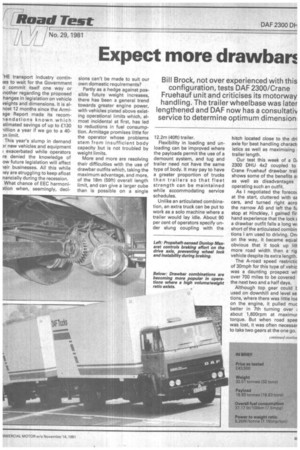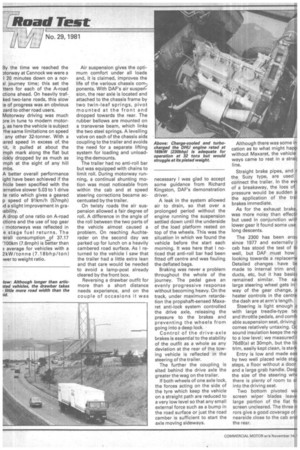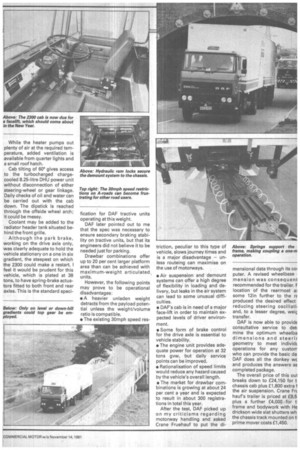Expect more drawbart
Page 55

Page 56

Page 57

If you've noticed an error in this article please click here to report it so we can fix it.
Bill Brock, not over experienced with this configuration, tests DAF 2300/Crane Fruehauf unit and criticises its motorway handling. The trailer wheelbase was later lengthened and DAF now has a consultativ service to determine optimum dimension.
HE transport industry continles to wait for the Government o commit itself one way or mother regarding the proposed hanges in legislation on vehicle weights and dimensions. It is allost 12 months since the Armi3ge Report made its recomiendations known which stimated savings of up to £130 iillion a year if we go to a 40)fl limit.
This year's slump in demand )r new vehicles and equipment ; exacerbated while operators re denied the knowledge of ow future legislation will affect left businesses. All this while ley are struggling to keep afloat nancially during the recession. What chance of EEC harmoniWon when, seemingly, deci
sions can't be made to suit our own domestic requirements?
Partly as a hedge against possible future weight increases, there has been a general trend towards greater engine power, with vehicles plated above existing operational limits which, almost incidental at first, has led to reductions in fuel consumption. Armitage promises little for the operator whose problems stem from insufficient body capacity but is not troubled by weight limits.
More and more are resolving their difficulties with the use of drawbar outfits which, taking the maximum advantage, and more, of the 18m (59ft) overall length limit, and can give a larger cube than is possible on a single 12.2m (40ft) trailer.
Flexibility in loading and unloading can be improved where the payloads permit the use of a demount system, and tug and trailer need not have the same type of body. It may pay to have a greater proportion of trucks than trailers so that fleet strength can be maintained while accommodating service schedules.
Unlike an articulated combination, an extra truck can be put to work as a solo machine where a trailer would lay idle. About 90 per cent of operators specify under slung coupling with the hitch located close to the dri axle for best handling characti istics as well as maximising trailer length.
Our test this week of a Do 2300 DH U 4x2 coupled to Crane Fruehauf drawbar trail shows some of the benefits al as well as disadvantages operating such an outfit.
As I negotiated the forecoi at the start, cluttered with sa cars, and turned right acro the narrow A5 and left the fu stop at Hinckley, I gained fir hand experience that the lock a drawbar outfit falls a long wi short of the articulated combin tions I am used to driving. On on the way, it became equal obvious that it took up litt more road width than a rig vehicle despite its extra length.
The A-road speed restrictic of 30mph for this type of vehic was a daunting prospect wim over 700 miles to be covered the next two and a half days.
Although top gear could I used on downhill and level se tions, where there was little loa on the engine, it pulled muc better in 7th turning over ; about 1,600rpm at maximur torque. But when road spee was lost, it was often necessar to take two gears at the one go. By the time we reached the Dtorway at Cannock we were a I 20 minutes down on a nor3I journey time; this set the ttern for each of the A-road ctions ahead. On heavily traf-, ked two-lane roads, this slow te of progress was an obvious zard to other road users.
Motorway driving was much Dre in tune to modern motorg, as here the vehicle is subject the same limitations on speed any other 32-tonner. With a ,ared speed in excess of, the lit, it pulled at about the mph mark along the flat but lickly dropped by as much as mph at the sight of any hill nibs,
A better overall performance ight have been achieved if the hide been specified with the :ernative slower 5.03 to 1 drive le ratio which gives a geared p speed of 91km/h (57mph) Id a slight improvement in gra A drop of one ratio on A-road ctions and the use of top gear motorways was reflected in e stage fuel returns. The 'erall consumption of 37.17 '100km (7.6mph) is better than ?. average for vehicles with a 2kW/tonne (7.18bhp/ton) wer to weight ratio. Air suspension gives the optimum comfort under all loads and, it is claimed, improves the life of the various chassis com ponents. With DAF's air suspen sion, the rear axle is located and attached to the chassis frame by two twin-leaf springs, pivot mounted at the front and dropped towards the rear. The rubber bellows are mounted on a transverse beam, which links the two steel springs. A levelling valve on each of the chassis aids coupling to the trailer and avoids the need for a separate lifting system for loading and unloading the demounts.
The trailer had no anti-roll bar but was equipped with chains to limit roll. During motorway running, a continual shunting motion was most noticeable from within the cab and at speed steering corrections became accentuated by the trailer.
On twisty roads the air suspension allowed a fair degree of roll. A difference in the angle of the roll between the two parts of the vehicle almost caused a problem. On reaching Auchterader on the second day we parked up for lunch on a heavily cambered road surface. As I returned to the vehicle I saw that the trailer had a little extra lean and that care would be needed to avoid a lamp-post already cleared by the front box.
Reversing a drawbar outfit for more than a short distance needs experience, and on the couple of occasions it was necessary I was glad to accept some guidance from Richard Kingston, DAF's demonstration driver.
A leak in the system allowed air to drain, so that over a prolonged period without the engine running the suspension settled down until the underside of the load platform rested on top of the wheels. This was the situation in which we found the vehicle before the start each morning. It was here that I noticed that anti-roll bar had been fitted off centre and was fouling the deflated bags.
Braking was never a problem throughout the whole of the journey. The pedal gave an evenly progressive response without becoming heavy. On the track, under maximum retardation the propshaft-sensed Maxaret anti-lock system controlled the drive axle, releasing the pressure to the brakes and preventing the wheels from going into a deep lock.
Control of the drive-axle brakes is essential to the stability of the outfit as a whole as any deviation at the rear of the towing vehicle is reflected in the steering of the trailer.
The further the coupling is sited behind the drive axle the greater the wag on the trailer.
If both wheels of one axle lock, the forces acting on the side of the tyre which keep the vehicle on a straight path are reduced to a very low level so that any small external force such as a bump in the road surface or just the road camber is sufficient to start the axle moving sideways. Although there was some in cation as to what might happ without Maxaret, the vehicle ways came to rest in a straic line.
Straight brake pipes, and r the Suzy type, are used connect the trailer. In the evE of a breakaway, the loss of pressure would be sudden a the application of the trai brakes immediate.
As for the exhaust brake, was more noisy than effecti, but used in conjunction with lower gear it found some use long descents.
The 2300 has been arou since 1977 and externally I cab has stood the test of tii well, but DAF must how looking towards a replaceme Detailed changes have IDE made to internal trim and ducts, etc, but it has basicE remained similar. The sal large steering wheel gets in 1 way of the gear change, a heater controls in the centre the dash are at arm's length.
Steering is light enough a with large treadle-type bri and throttle pedals, and =rift able suspension seat, driving I comes relatively untaxing. Gc sound insulation keeps the no to a low level; we measured i 76dB(a) at 30mph, but the bli trim, easily kept clean, is stark Entry is low and made eas by two well placed wide stag steps, a floor without a door and a large grab handle. Desp the size of the steering whE there is plenty of room to sl into the driving seat.
Two bottom pivoted wil screen wiper blades leave large portion of the flat fn screen uncleared. The three n rors give a good coverage of nearside close to the cab and the rear. While the heater pumps out plenty of air at the required temperature, added ventilation is available from quarter lights and a small roof hatch.
Cab tilting of 600 gives access to the turbocharged chargecooled 8.25-litre DHU power unit without disconnection of either steering-wheel or gear linkage. Daily checks of oil and water can be carried out with the cab down. The dipstick is reached through the offside wheel arch; it could be messy.
Coolant may be added to the radiator header tank situated behind the front grille.
Although the park brake, working on the drive axle only, was clearly adequate to hold the vehicle stationary on a one in six gradient, the steepest on which the 2300 could make a restart. I feel it would be prudent for this vehicle, which is plated at 38 tons, to have spring-brake actuators fitted to both front and rear axles. This is the standard speci fication for DAF tractive units operating at this weight.
DAF later pointed out to me that the spec was necessary to ensure secondary braking stability on Tractive units, but that its engineers did not believe it to be needed just for parking.
Drawbar combinations offer up to 20 per cent larger platform area than can be achieved with maximum-weight articulated units.
However, the following points may prove to be operational disadvantages:
.A heavier unladen weight detracts from the payload potential unless the weight/volume ratio is compatible.
• The existing 30mph speed res triction, peculiar to this type of vehicle, slows journey times and is a major disadvantage — unless routeing can maximise on the use of motorways.
• Air suspension and demount systems can offer a high degree of flexibility in loading and delivery, but leaks in the air system can lead to some unusual difficulties.
• DAF's cab is in need of a major face-lift in order to maintain expected levels of driver environ ment.
• Some form of brake control for the drive axle is essential to vehicle stability.
• The engine unit provides adequate power for operation at 32 tons gvw, but daily service points can be improved.
• Rationalisation of speed limits would reduce any hazard caused by the vehicle's overall length.
• The market for drawbar combinations is growing at about 24 per cent a year and is expected to result in about 300 registrations in total this year.
After the test, DAF picked up on my criticisms regarding motorway handling and asked Crane Fruehauf to put the di mensional data through its col puter. A revised wheelbase mension was consequent recommended for the trailer. F location Of the rearmost a) some 12in further to the rE produced the desired effect reducing steering oscillatit and, to a lesser degree, weic transfer.
DAF is now able to providE consultative service to deb mine the optimum wheelba dimensions and steerir geometry to meet individi. operations for any custom who can provide the basic da DAF does all the donkey wc and produces the answers as completed package.
The overall price of this our breaks down to £24,150 for t chassis cab plus £1,800 extra f the air suspension. Crane Fri hauf's trailer is priced at £8,5 plus a further £4,000 for ti frame and bodywork with He clrickson wide slat shutters wh the chassis track mounted on ti prime mover costs £1,450.






















































































